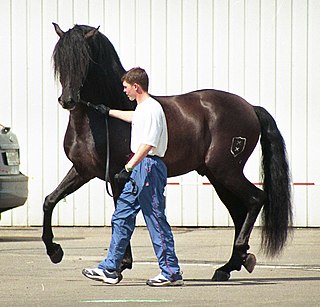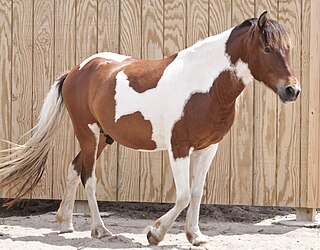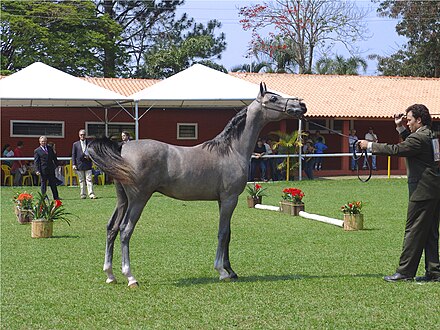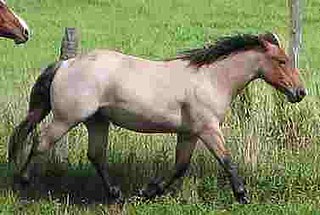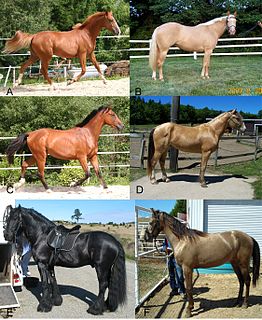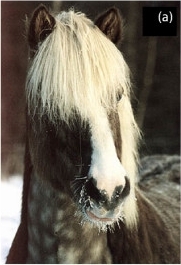It has been requested that the title of this article be changed to Gray horse . Please see the relevant discussion. The page should not be moved unless the discussion is closed; summarizing the consensus achieved in support of the move. |
| Gray | |
|---|---|
 A gray Lipizzan horse. Grays are typically born a darker color, and their hair coat will be pure white before they are 10 years old as they age | |
| Other names | Grey |
| Variants |
|
| Genotype | |
| Base color | Any |
| Modifying genes | Graying gene (G) dominant when single allele present |
| Phenotype | |
| Body | Born any color, progressively lightens with age until completely white, flea-bitten form may develop red hairs in a freckling pattern throughout coat, sometimes increasing with age |
| Head and Legs | May not gray at same rate as body, head may be first part of body to lighten, legs may be among last parts of body to lighten |
| Mane and tail | May not gray at same rate as body, lighter or darker |
| Skin | Usually black, except under white markings present at birth |
| Eyes | Usually dark brown, unless base color affected by other genes which lighten eye color |
| Other notes | Dominant over all other coat colors, when gray gene is present, horse will always become gray, may be masked if horse's base color is white |

Gray or grey is a coat color of horses characterized by progressive silvering of the colored hairs of the coat. Most gray horses have black skin and dark eyes; unlike many depigmentation genes, gray does not affect skin or eye color. [1] Their adult hair coat is white, dappled, or white intermingled with hairs of other colors. Gray horses may be born any base color, depending on other color genes present. White hairs begin to appear at or shortly after birth and become progressively lighter as the horse ages. Graying can occur at different rates—very quickly on one horse and very slowly on another.

Horses exhibit a diverse array of coat colors and distinctive markings. A specialized vocabulary has evolved to describe them.

The horse is one of two extant subspecies of Equus ferus. It is an odd-toed ungulate mammal belonging to the taxonomic family Equidae. The horse has evolved over the past 45 to 55 million years from a small multi-toed creature, Eohippus, into the large, single-toed animal of today. Humans began domesticating horses around 4000 BC, and their domestication is believed to have been widespread by 3000 BC. Horses in the subspecies caballus are domesticated, although some domesticated populations live in the wild as feral horses. These feral populations are not true wild horses, as this term is used to describe horses that have never been domesticated, such as the endangered Przewalski's horse, a separate subspecies, and the only remaining true wild horse. There is an extensive, specialized vocabulary used to describe equine-related concepts, covering everything from anatomy to life stages, size, colors, markings, breeds, locomotion, and behavior.
Contents
- Prevalence
- Changes in the color of gray horses
- Young gray horses
- Dapple gray
- The "flea-bitten" gray
- The genetics of gray
- Horse coat colors sometimes confused with gray
- White horses
- Roan
- Diluted colors
- Mythology
- See also
- Notes
- References
Gray horses appear in many breeds, though the color is most commonly seen in breeds descended from Arabian ancestors. Some breeds that have large numbers of gray-colored horses include the Thoroughbred, the Arabian, the American Quarter Horse, the Percheron, the Andalusian, the Welsh pony, and the most famous of all gray horse breeds, the Lipizzaner.

The Arabian or Arab horse is a breed of horse that originated on the Arabian Peninsula. With a distinctive head shape and high tail carriage, the Arabian is one of the most easily recognizable horse breeds in the world. It is also one of the oldest breeds, with archaeological evidence of horses in the Middle East that resemble modern Arabians dating back 4,500 years. Throughout history, Arabian horses have spread around the world by both war and trade, used to improve other breeds by adding speed, refinement, endurance, and strong bone. Today, Arabian bloodlines are found in almost every modern breed of riding horse.

The Thoroughbred is a horse breed best known for its use in horse racing. Although the word thoroughbred is sometimes used to refer to any breed of purebred horse, it technically refers only to the Thoroughbred breed. Thoroughbreds are considered "hot-blooded" horses that are known for their agility, speed, and spirit.

The American Quarter Horse, or Quarter Horse, is an American breed of horse that excels at sprinting short distances. Its name came from its ability to outdistance other horse breeds in races of a quarter mile or less; some have been clocked at speeds up to 55 mph (88.5 km/h). The American Quarter Horse is the most popular breed in the United States today, and the American Quarter Horse Association is the largest breed registry in the world, with almost 3 million living American Quarter Horses registered in 2014.
People who are unfamiliar with horses may refer to gray horses as "white". However, a gray horse whose hair coat is completely "white" will still have black skin (except under markings that were white at birth) and dark eyes. This is how to discern a gray horse from a white horse. White horses usually have pink skin and sometimes even have blue eyes. Young horses with hair coats consisting of a mixture of colored and gray or white hairs are sometimes confused with roan. Some horses that carry dilution genes may also be confused with white or gray.

Markings on horses are usually distinctive white areas on an otherwise dark base coat color. Most horses have some markings, and they help to identify the horse as a unique individual. Markings are present at birth and do not change over the course of the horse's life. Most markings have pink skin underneath most of the white hairs, though a few faint markings may occasionally have white hair with no underlying pink skin. Markings may appear to change slightly when a horse grows or sheds its winter coat, however this difference is simply a factor of hair coat length; the underlying pattern does not change.

White horses are born white and stay white throughout their lives. White horses may have brown, blue, or hazel eyes. "True white" horses, especially those that carry one of the dominant white (W) genes, are rare. Most horses that are commonly referred to as "white" are actually "gray" horses whose hair coats are completely white and may be born of any color and gradually "gray" as time goes on and take on a white appearance.

Roan is a horse coat color pattern characterized by an even mixture of colored and white hairs on the body, while the head and "points"—lower legs, mane and tail—are mostly solid-colored. Horses with roan coats have white hairs evenly intermingled throughout any other color. The head, legs, mane and tail have fewer scattered white hairs or none at all. The roan pattern is dominantly-inherited, and is found in many horse breeds. While the specific mutation responsible for roan has not been exactly identified, a DNA test can determine zygosity for roan in several breeds. True roan is always present at birth, though it may be hard to see until after the foal coat sheds out. The coat may lighten or darken from winter to summer, but unlike the gray coat color, which also begins with intermixed white and colored hairs, roans do not become progressively lighter in color as they age. The silvering effect of mixed white and colored hairs can create coats that look bluish or pinkish.
While gray is commonly called a coat color by breed registries, genetically it may be more correct to call it a depigmentation pattern. It is a dominant allele, [1] and thus a horse needs only one copy of the gray allele, that is, heterozygous, to be gray in color. A homozygous gray horse, one carrying two gray alleles, will always produce gray foals.
A breed registry, also known as a herdbook, studbook or register, in animal husbandry and the hobby of animal fancy, is an official list of animals within a specific breed whose parents are known. Animals are usually registered by their breeders while they are young. The terms studbook and register are also used to refer to lists of male animals "standing at stud", that is, those animals actively breeding, as opposed to every known specimen of that breed. Such registries usually issue certificates for each recorded animal, called a pedigree, pedigreed animal documentation, or most commonly, an animal's "papers". Registration papers may consist of a simple certificate or a listing of ancestors in the animal's background, sometimes with a chart showing the lineage.
Depigmentation is the lightening of the skin or loss of pigment. Depigmentation of the skin can be caused by a number of local and systemic conditions. The pigment loss can be partial or complete. It can be temporary or permanent.
An allele is a variant form of a given gene. Sometimes, different alleles can result in different observable phenotypic traits, such as different pigmentation. A notable example of this trait of color variation is Gregor Mendel's discovery that the white and purple flower colors in pea plants were the result of "pure line" traits which could be used as a control for future experiments. However, most alleles result in little or no observable phenotypic variation.
